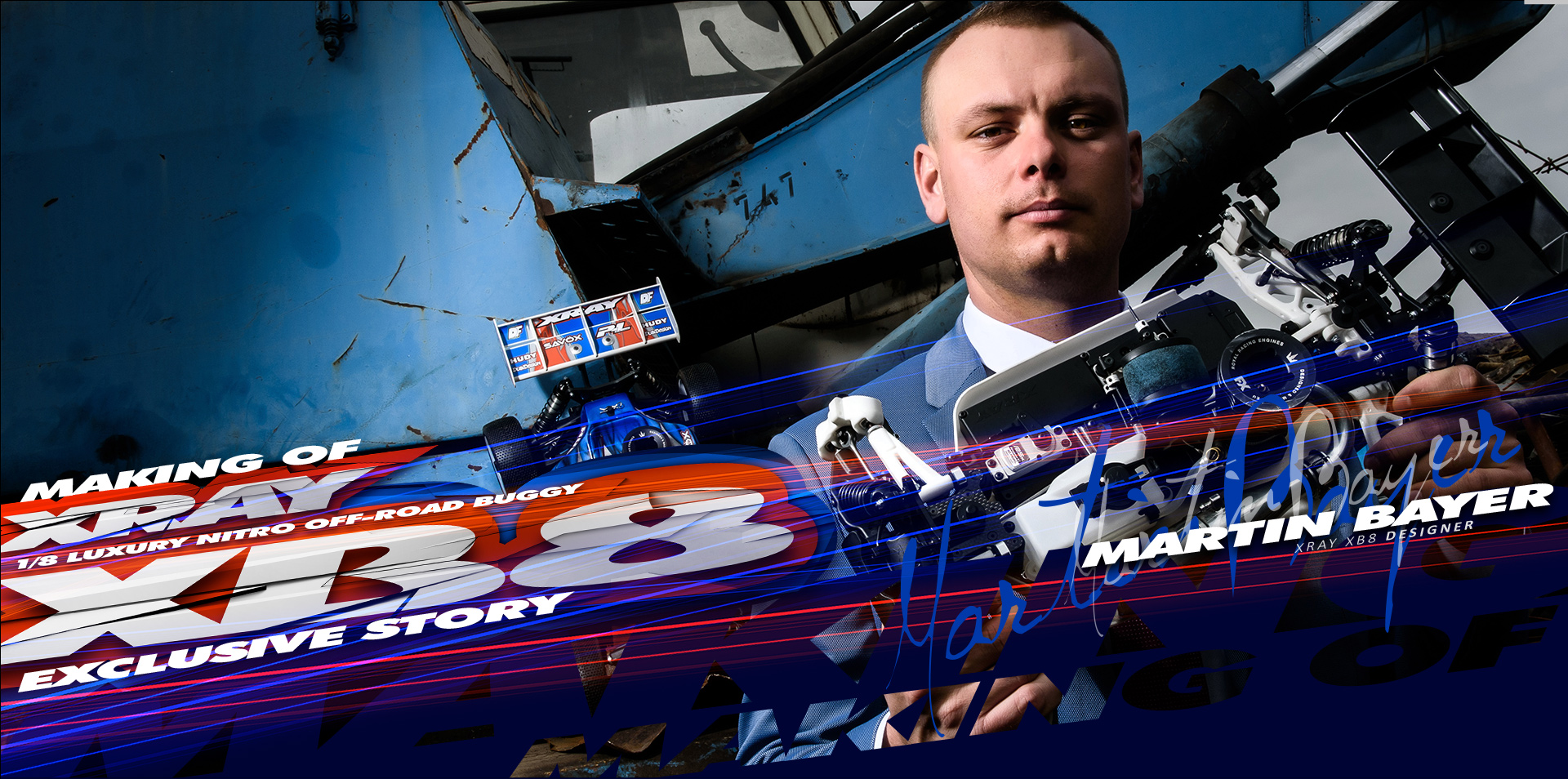
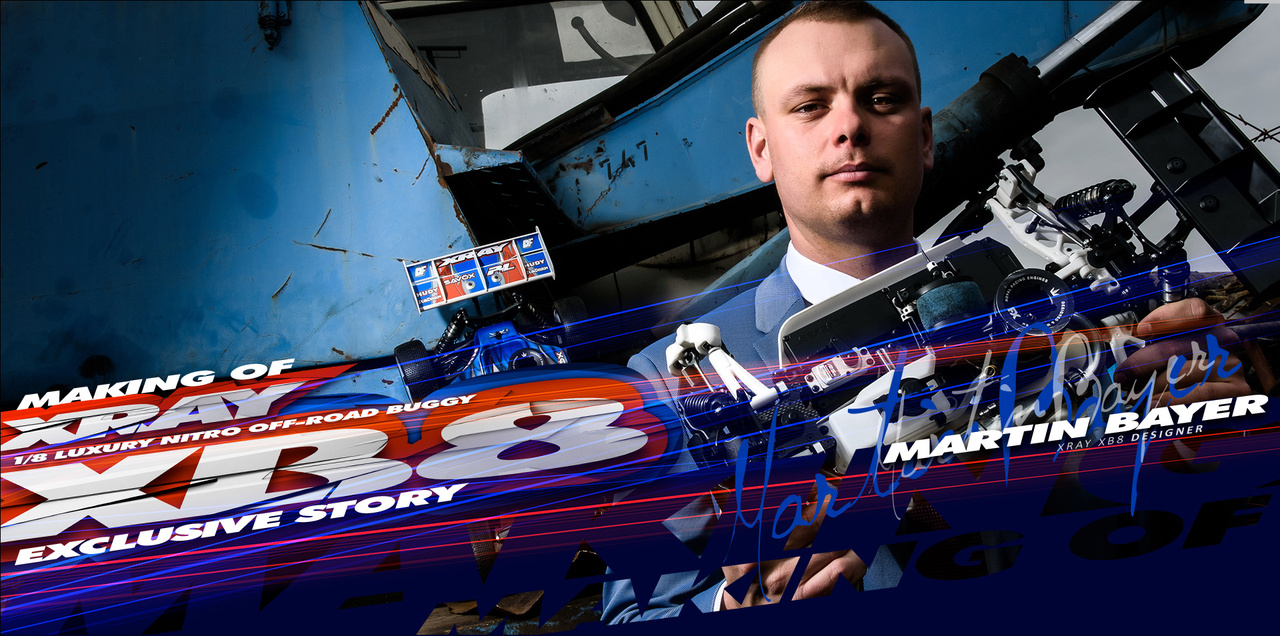
If you think that you can take a rest at XRAY when you finish a project, well… you would be wrong. There is no time for breaks; the working tempo of the entire internal team, and especially of Juraj, is just insane, but, of course, inspiring. After my first full involvement with the XB2 development – which I shared with you in my previous Exclusive store here – I did not want to miss this opportunity, and so I was back in the loop, this time with the XB8 project.
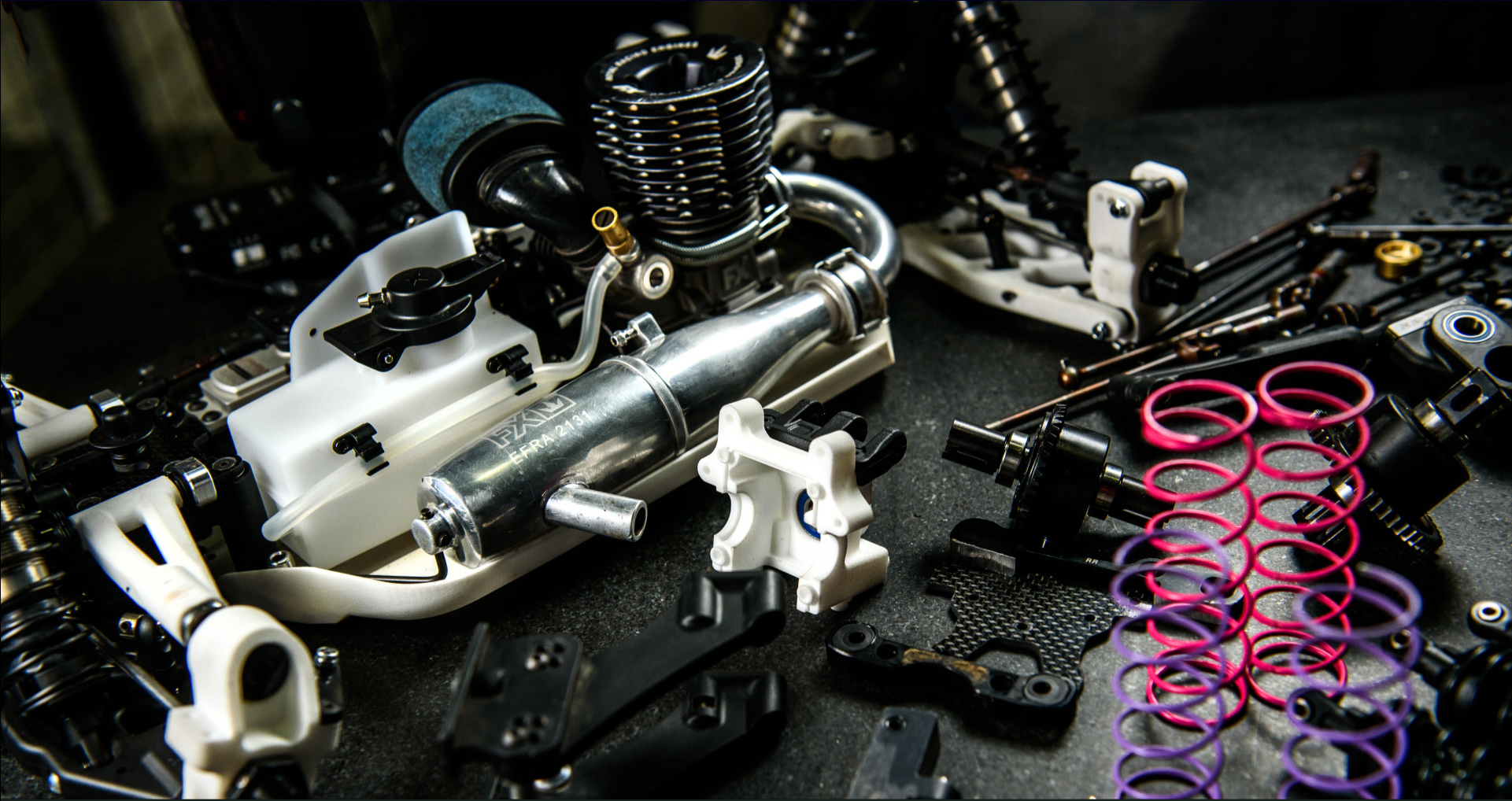
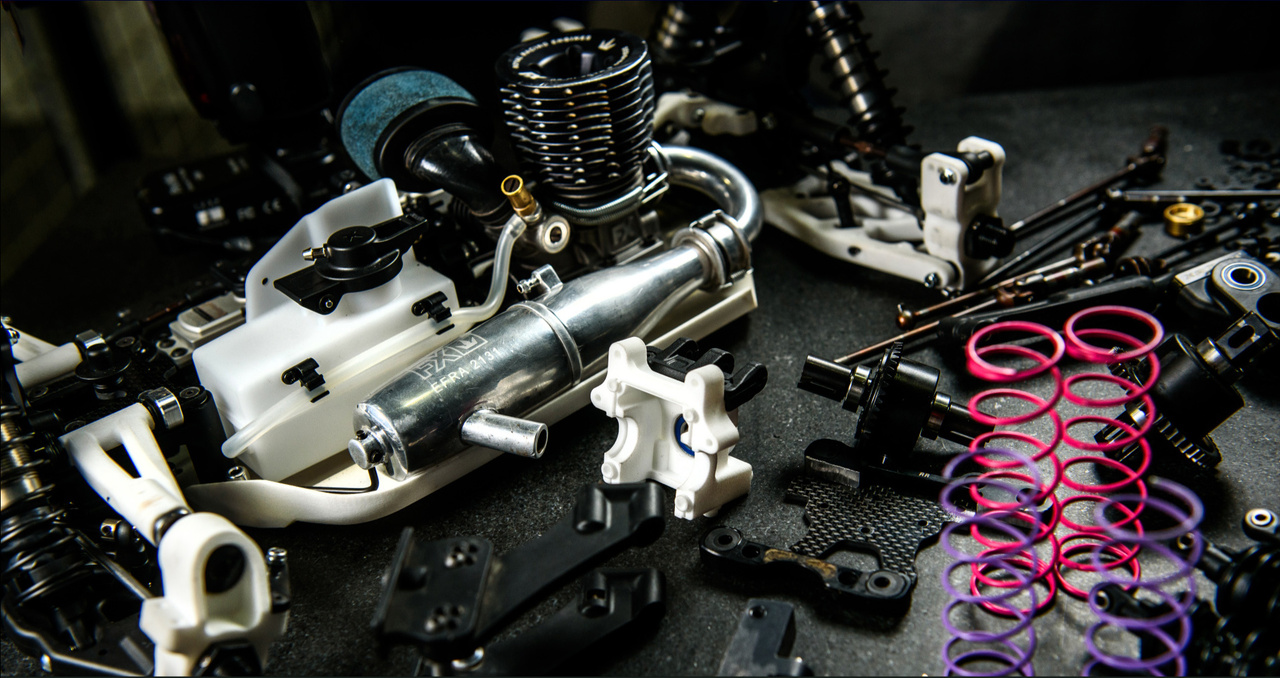
I was already involved with the XB8 platform in previous years, but this time I took over responsibility for the entire development of this platform from Juraj. Already having extensive experience, I knew exactly what to expect, so I was ready for plenty of work in the office, plenty of travelling, and of course plenty of track time and wrenching. But whatever I was expecting, reality greatly surpassed my expectations.

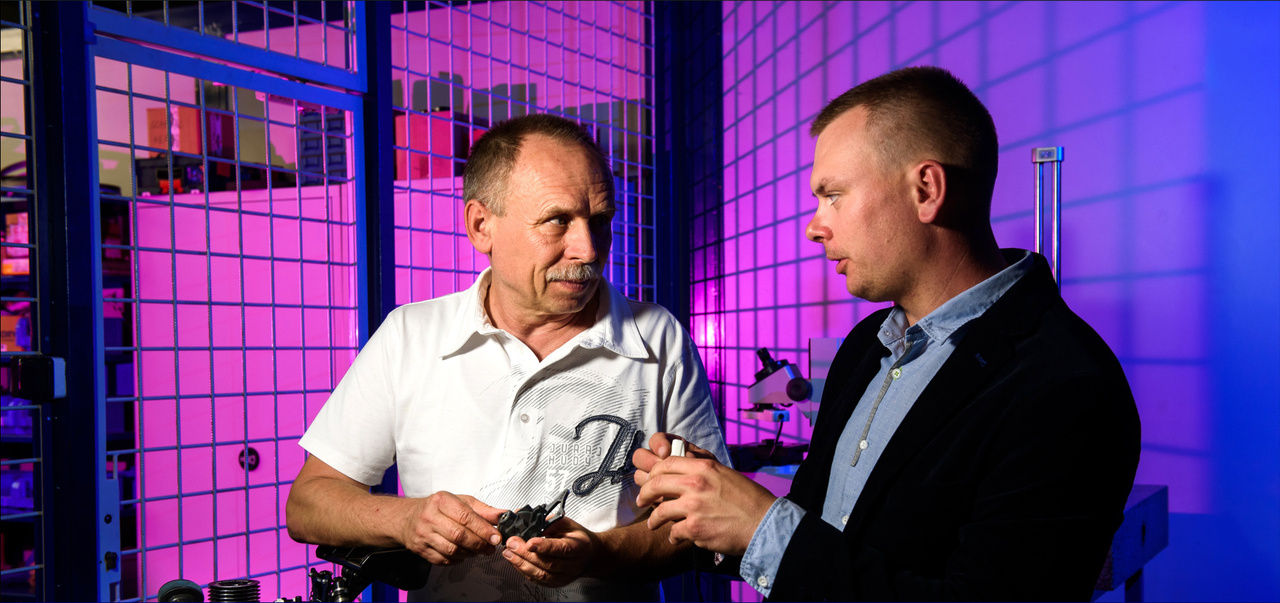
As usual we started work by taking the existing car, reading through all the feedback and comments received from customers, team drivers, distributors, and then putting down all my own comments. From this I divided things into a list of details that I would change, details that should be changed, and then also all details that I did not want to change and wanted to carry over. I also had to keep in mind that we needed to use the same platform for the electric version of XB8, and we had to keep everything open for the XT8 truggy version.


XB8 details I wanted to improve for 2016 version:
• Eliminate suspension binding in dusty conditions
• Eliminate vibrations in rear suspension from transferring to the shock tower
• Gain more steering
• Increase stability & predictability
• Improve rear traction
• Improve the flex
• Reinforce weak points
• Improve the performance of the body
• Test the Lexan wing


XB8 details I wanted to carry over to the 2016 version:
• Carry over the entire platform, with maximum parts compatibility
• Keep most of the layout from the XB8 platform (in general)
• Keep the reliability of the car
• Use the same well-proven suspension geometry
• Continue with the principle of pivot ball suspension


Task #1: Eliminate suspension binding in dusty conditions
I was very happy with the performance of the original XRAY pivot ball suspension that we introduced back in 2014; the range of adjustments and how easily all adjustments could be achieved made it a joy to work on the car. However on very dusty tracks we continued to experience problems with binding suspension as the dust blocked the free working of the upper pivot ball.


Task #2: Eliminate vibrations in rear suspension from transferring to the shock tower
On very rough tracks, vibrations from the rear suspension were transferred to the car. Whatever I did with the shocks and set-up of the rear end, I still could not get the car to stay calm when running over rough terrain.


I was convinced that the strange handling over rough bumps comes from vibrations when the suspension transfers energy through shocks to the shock tower, and then via rear brace to the chassis. All this has a negative impact on the handling of the car.


Solution:
This time the solution was straightforward and fairly easy. I redesigned the rear chassis brace, which was mounted to the mounting holder on the rear bulkhead instead of the shock tower. After making a quick prototype from polyamide, I did a quick test which confirmed my theory.


Solution:
The first solution I tried was to use small foam pieces that I have installed on the pivot ball which was a slight improvement but certainly far away from a complete professional solution. I tried to increase the play in the upper composite ball joint which of course resulted in wobbly suspension, but still the dust that got inside locked up the movement.
After some brainstorming with Juraj, we were convinced that we needed to change the upper pivot ball from vertical mounting to a horizontal mounting system. This would mean we would have to go in the direction of conventional pivot ball suspension design.


We worked with Juraj to give this a try and to see if our expectation was correct. The engineers drew the entire front suspension with the conventional pivot ball system, production quickly made a few rapid prototypes for testing, and then we gave it a try. Our expectation was correct: the horizontal pivot ball mounting system worked well in dusty conditions. So despite my wanting to continue to use our unique pivot ball suspension, we would need to change the front end to solve the binding issue.


With the brace not mounted to the shock tower, the car was suddenly very smooth over the rough bumps and finally I had full control over the car no matter how rough the track was. The mounting of the brace is now positioned in a composite holder which has a bit of play so the brace has a minor small side flex which helps the forgiveness of the car for the regular drivers.


Since we needed to make an all-new mould for the brace, Juraj came up with an idea to make the brace additionally adjustable in the terms of stiffness. After running through a few different alternatives, we came up with the final design that allows to additionally mount graphite inserts into both sides of the rear brace to make it even stiffer.


Task #3: Gain more steering
Like everyone else in all the categories, we continue to hunt for more steering and more traction, because there is never enough of either. J The previous XB8 had significantly improved steering characteristics, but I still felt we could get a bit more.


Solution:
To play around with the steering, we designed & produced several different designs of the steering plate, tested them with different Ackermann and bumpsteer adjustment shims, and tried different height positions of the steering plate.
I spent a few days at the tracks doing back-to-back testing of different designs and alternatives to find the best solution. We came to the point where we needed to redesign the chassis as well, and as such when making different chassis prototypes I also had to produce different chassis with different steering system positions.
Personally I liked the universal drive shafts which gave slightly more steering, as the drive shafts were slightly less binding when the wheels were in full steering lock.


With the new steering blocks we can now independently change the Ackermann extensions to another adjustment possibility. With previous experience with these steering extensions from XB2, I knew exactly what we wanted to test, so this time it was easy in the design phase but of course time extensive in testing.


With the combination of different steering plates, steering block extensions, and different chassis with different steering system position, there was a lot of extra work & effort to find the best possible combination that would be a working solution for all different track conditions.


After extensive testing, I selected the best combinations that I liked and provided them to Juraj for his own testing. Juraj felt pretty much the same differences in steering characteristics, and at the end when we had to choose the final solution we decided on the design with a more forward chassis position. All the new geometry resulted in increased and more smooth steering. I was satisfied, and another checkpoint was made.
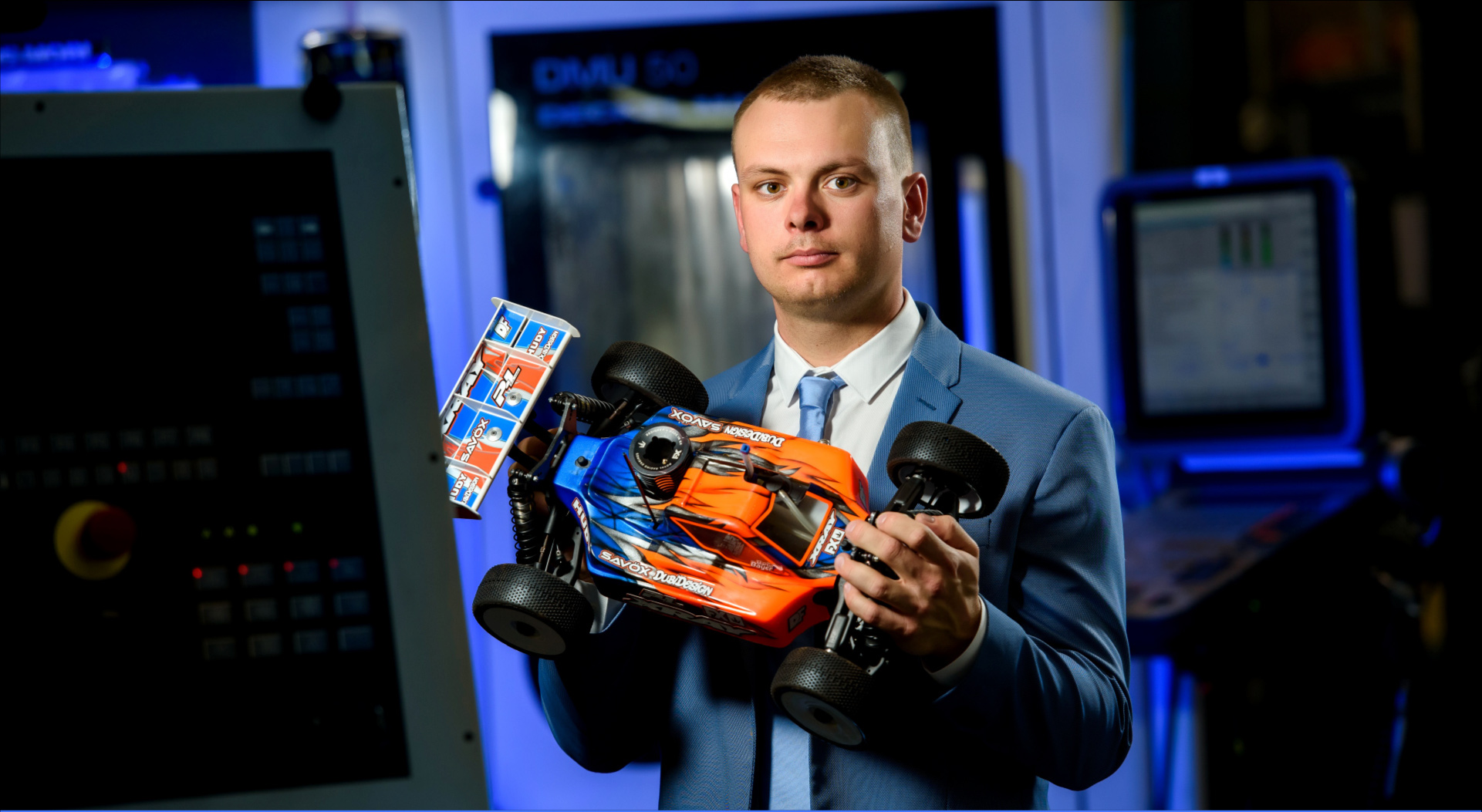

Task #4: Increase stability & predictability
Top drivers are able to race and win with twitchy cars, but for regular drivers the key to success at races is to have a car that is stable & predictable. The XB8 platform has had improved stability, but we still get frequent requests from customers to make the car more stable, especially at rough tracks.


Solution:
There are several ways to increase the stability of a car, but the tricky part is to find proper balance because a more stable car generally has less cornering speed, and it usually is more ‘square.’ The stability of the new XB8 comes from the several other areas we have worked on and changed, including:


• New weight balance: We shortened the chassis by 4mm to make the car easier to control and moved the weight by moving electronics, center diff, fuel tank and engine all frontwards. The wider design of the chassis in the rear helped with stability and the narrower design of the chassis in the front helps to increase traction as well to improve steering.
• New chassis flex & overall car flex:
To get the proper chassis flex, I made and tested several different chassis layouts all with slightly different longitudinal and side-to-side flex characteristics. All these different designs were tested in combination with different chassis braces, different radio boxes from different composite material, and different side guards.


• New braces flex: Not only was the rear brace completely redesigned with a new flex characteristics independent from the rear shock tower, but also the front brace was redesigned to be shorter and only with 1-screw mounting to prevent the front brace from negatively influencing the chassis flex.


• New side guards: On the previous XB8 we completely removed the reinforcement ribs, which in some track conditions made the car much too stiff. However, the design of the guards was still not optimal at tracks with rough surface; the edges of the guards sometimes got into contact with the ground which of course has a negative influence on performance. As such, we decided to completely redesign the side guard’s layout, to make the edges with large radius so even in the roughest tracks the side guards would not contact the track. The simplified design of the guards made it also easier to predict the flex and of course we tested various composite mixtures all with different hardnesses. I found using a softer composite mixture instantly gave the car more traction.


Task #5: Get more traction in the rear
The traction of the car has already improved with the new universal drive shafts, the new weight balance, new flex, and also the new rear brace mounting system. All of these changes have clearly helped with the traction of the car, but I still felt that more traction was possible.


Task #9: Test & compare the Lexan wing
With the new trend of Lexan wings, I wanted to do extensive testing before any changes were made. I am not a fan of quick changes due to trends or hype, but rather I take the traditional attitude of “test first, then make.”


• New radio box flex: I started to test different hand modifications to the radio box already last year, to experience and understand the influence of different modifications of the radio box layouts on the handling of the car. Most tests were made with different positions of the radio box in the chassis to move the balance, but also by making modifications to the radio box to make it either softer or stiffer and to see how each of these would impact the handling of the car.

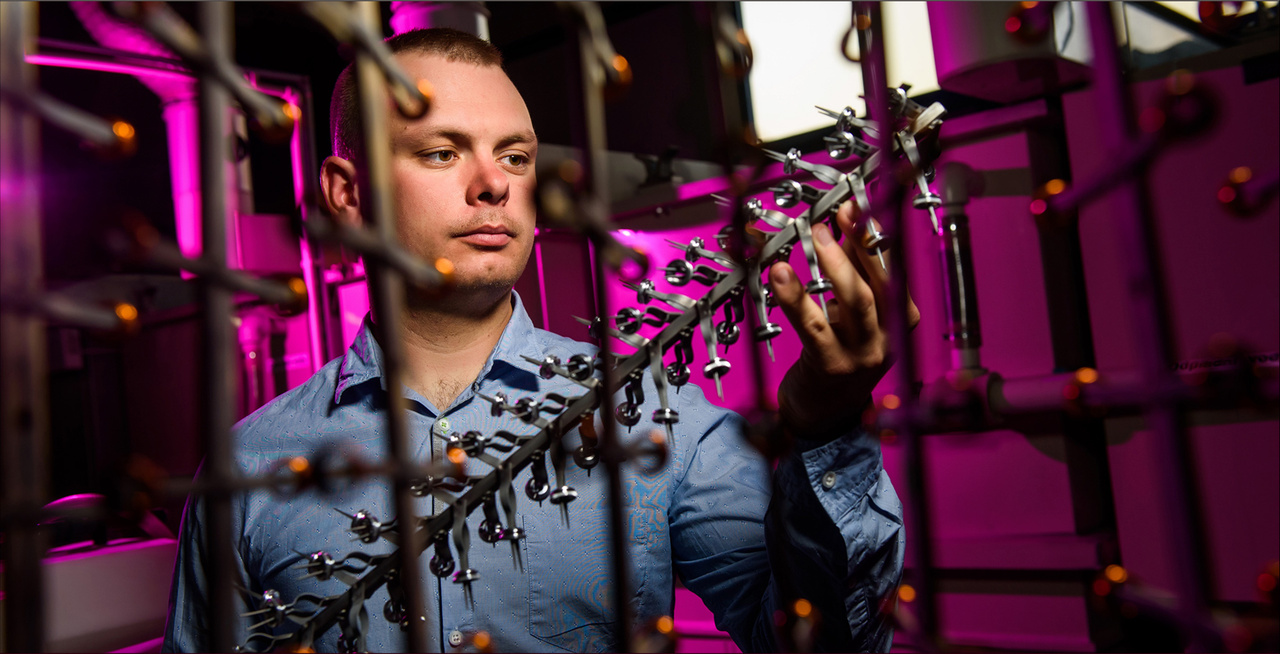
• New universal drive shafts: For a few years I have been testing & comparing the CVD drive shafts used by XB8 platform with universal drive shafts we have used in the early beginnings. In some track conditions – especially on high-traction tracks – I did not see any particular difference. But on low-traction tracks, I felt that the universal drive shafts generate slightly more traction. To verify if it was just a 1-time feeling, I continued to test and compare but my findings seemed to be same in ongoing tests.


Solution:
When we changed to the all-new XB8 platform in 2014, I always felt that a bit of rear traction was lost and I was suspicious that it is because of the 2-piece uprights and the upper aluminum bracket which reinforces the whole assembly. That design makes adjustments not that easy, but I felt that the full composite uprights generated a bit more traction.
To prove or deny my feelings, I modified the old previous 1-piece composite uprights, installed them on the car, and ran them for several races at different tracks and checked & compared them back-to-back with the 2-piece uprights. To be sure that this was not only just my personal feelings, we again had Juraj do the same tests. He agreed with my findings, and approved the creation of new 1-piece composite uprights. I was again satisfied when another small improvement part was finished, and we continued to solve the puzzle of what should be changed and improved.


Task #6: Improve the flex
The flex of the chassis, braces, suspension parts – as well as overall flex of the cars – are probably the most important factors and characteristics that influence the handling and performance of an RC car.
Solution:
Every single change I make to the car has to be reviewed for how it will affect the flex. All the changes I have made and described so far had all been considered and tested on their influence on the overall flex of the car, and most of the changes were all positive. The one area I was still not completely sure about was the radio box.
I had plenty of differently modified radio boxes, and every of them provided the car with a slightly different feeling because of different flex.




Here are some of the things I did to the radio boxes to test the effects on flex:
• Drilled in various areas to change the stiffness
• Cuts in longitudinal or horizontal directions
• Cut into more pieces to separate the different parts of the box
• More mounting positions to the chassis
• Less mounting positions to the chassis
• And of course, all these alternatives were moulded from different composite mixtures: soft – medium – hard


At one point I felt like a “master of radio boxes” coming to any track I spent most of the time changing and testing various boxes and comparing them back-to-back. Some of the designs worked perfectly in high-traction conditions but were not suitable for low-traction and vice-versa. I had to admit that it might be impossible to find one that would work perfectly in all the different conditions, so I came to the point where I needed to choose the best possible solution.


The more I tested and had to keep all the related details on mind, the more I was convinced that the best possible solution (which would also be fastest solution) would be to use the standard design of the radio box but moulded from a soft composite. This version of the radio box would not require any further changes to the mould, and by not making changes to other parts other than using a softer composite, this definitely helped the car to flex more and generate more traction.


We have redesigned the way the radio box is mounted to the chassis to ensure that the radio box will have minimum effect on the chassis flex. I was happy with the final decision until I realized in some test sessions on very fast tracks, the softer radio box has a negative side effect when the throttle servo pulls the radio box when the throttle servo arm is moving. Of course this was a not desired effect and I felt like I was right back at the beginning of the problem.


Good ideas come with a fresh mind, and this time was no exception. After a short break from the problem, I came up with a very easy and straightforward solution. To stop the throttle servo from moving but to keep the radio box as flexible as it was, I added a turnbuckle linkage between the center bulkhead assembly and the throttle servo. This ensured that the servo would not move when the throttle was applied, while the radio box could still move & flex as required. It was an easy & smart solution which put us back on track.


Task #7: Reinforce weak points
It is not surprising that XRAY cars are considered to be the most reliable and strongest RC cars in the industry. Since the very first version released a decade ago, the XB8 has been one of the strongest and most reliable off-road cars thanks to ongoing development and yearly improvements. There are not many areas that would require reliability improvement, but still there were a few I had in mind.


Solution:
There were basically only two parts I wanted to improve upon: the diff bulkhead and the ball-bearings. While updating the mould of the bulkheads to fit the new brace mounting system, we made several small modifications to the bulkheads to make them stronger and more reliable. To improve the reliability of the ball-bearings, we returned to greased bearings instead of using light oil which we had changed to a few years ago. I have learned that most drivers do not service their bearings as frequently as they should, so without the grease the bearings were more susceptible to dust and dirt. At the end we use the bearings with light oil only in the steering system to ensure absolutely free movement of the entire steering assembly.


Task #8: Improve the performance of the body
The body and wing have a significant influence on handling and performance, and as such it is an area in which we pay special attention. The design of the body is also a matter of brand identity, and differentiates the cars among others on the track. Therefore the look of the body is also matter of a functional design.
With the new trend of easy & straight lines design, we made improvement to the performance of the body since last year, but with our new experiences from the design of the XB4 body I wanted to play around the front cabin, sidewalls, and flow-channels to see how much I can improve the stability and landing after large jumps.


Solution:
The development of the body takes a fairly a long time because in this case we make all the modifications to the mould manually and we have to consider every change in a detail because of the changes in the mould. To arrive at the final design took four different stages, each with a separate prototype. This process probably took the longest time in development. To gain more stability we changed the front cabin to a more vertical front window, moved the entire cabin more forwards, and redesigned the flow of the air across the top of the body.
We also narrowed the whole cabin area so it cuts through the air better and has better stability when the car rolls in corners…which also helps when the car is landing after long jumps. All these modifications were made step-by-step during the four different development stages, and I tested the body for a few months at different tracks with a significant improvement almost everywhere.


Solution:
The solution was easy: test the Lexan wings and compare them against our wing which I still consider to be one of the best in the industry for both performance & reliability. I have done plenty of different tests in different track conditions, and I believe there is a future for the Lexan™ wing, but certainly we did not want to rush anything at this moment. However to be honest, the reliability and lifespan of the Lexan wing is much lower, which may be the main obstacle for regular customers. At this moment I am unsure what we will do with the Lexan wing, but I certainly see a potential to further explore and work on. Maybe we will start first with an optional wing and collect long-term feedback from regular customers to get more information to make a decision.


Tests, tests, and even MORE tests
With a very clear idea of all things I wanted to change, I knew that we would be doing “old school” back-to-back testing & comparison of prototypes, recording all the data, analyzing it all, and then deciding on the final specs of the car. They may call it “old school” but it is still the best way to do this without risking creating something that might not do well in long-term tested or even work at all.


Considering that I was involved at the same time with other XRAY off-road platforms and the lack of time I had, there was no choice but to speed up the initial first testing by doing all the tests on my own, then only afterwards provide the team with those selected prototypes which I was convinced were major improvement so that more drivers could confirm my findings in different track conditions. In the end, I believe this strategy has worked and I also saved a lot of time for the drivers by providing them with clearly improved cars; they did not have to waste any time eliminating any non-working parts during the prototype phase.
I also knew that any time I was unsure about something, I could count on good input from Juraj who represents the “average Joe” racer. This system has proved to be fast & efficient, and we were doing miracles in much shorter times.


For a non-involved person it may sound logical to go and test all these new parts 1-by-1, but unfortunately I did not have time to do that. I submitted to Production a list of all those parts required for the first phase of testing. Since our biggest change in car design & layout would certainly be the front pivot ball suspension, the first prototype we would be testing would be the front pivot ball suspension in the current XB8 platform.
It was an obvious starting point to test & record data on the existing pivot ball suspension (contrary to the conventional pivot ball suspension); we needed to test the very same car we already had knowledge & experience with. So we quickly produced a rapid prototype of the conventional front pivot ball and installed it into my car that I used the whole season, in order to feel all the differences.
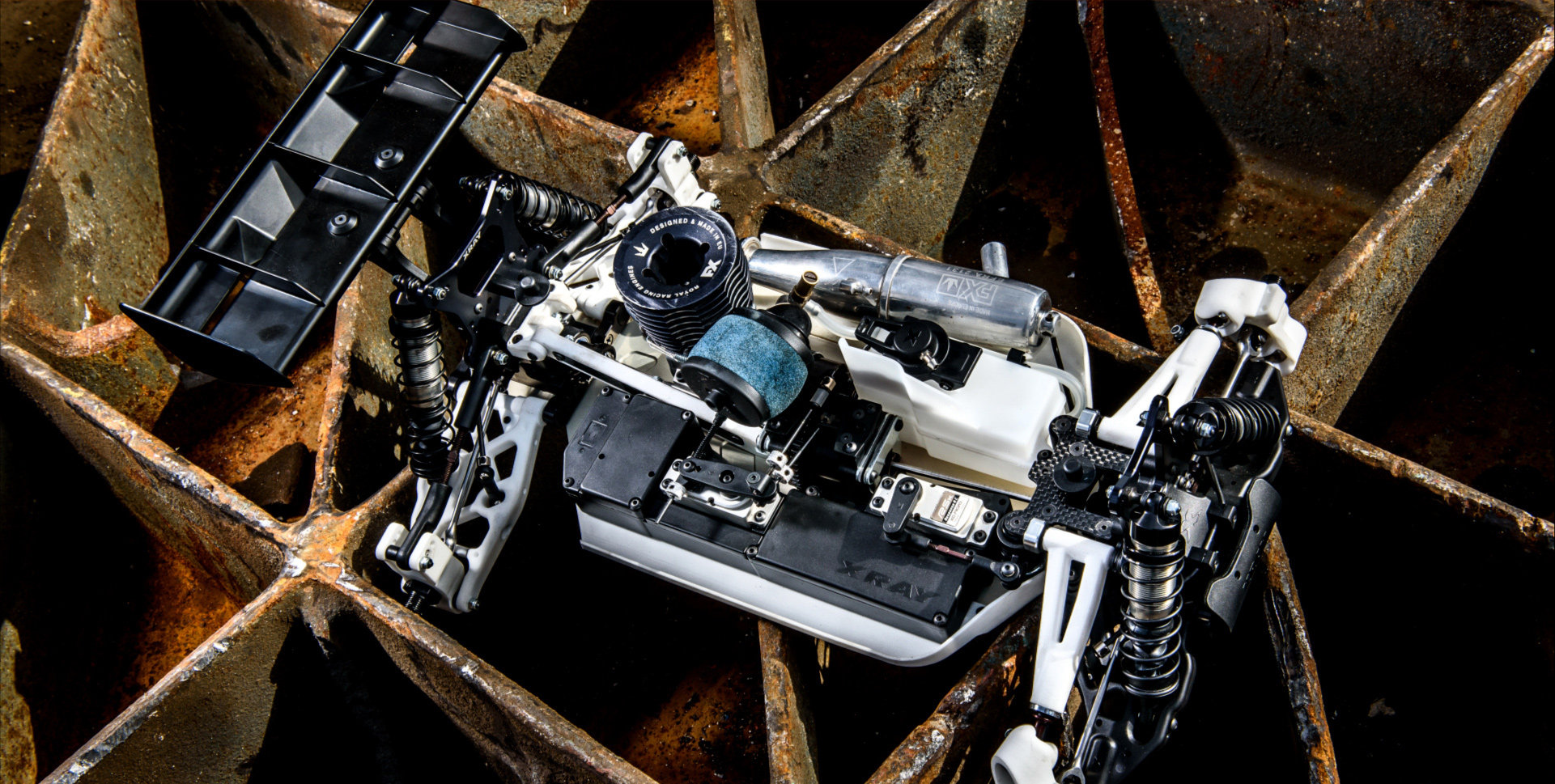
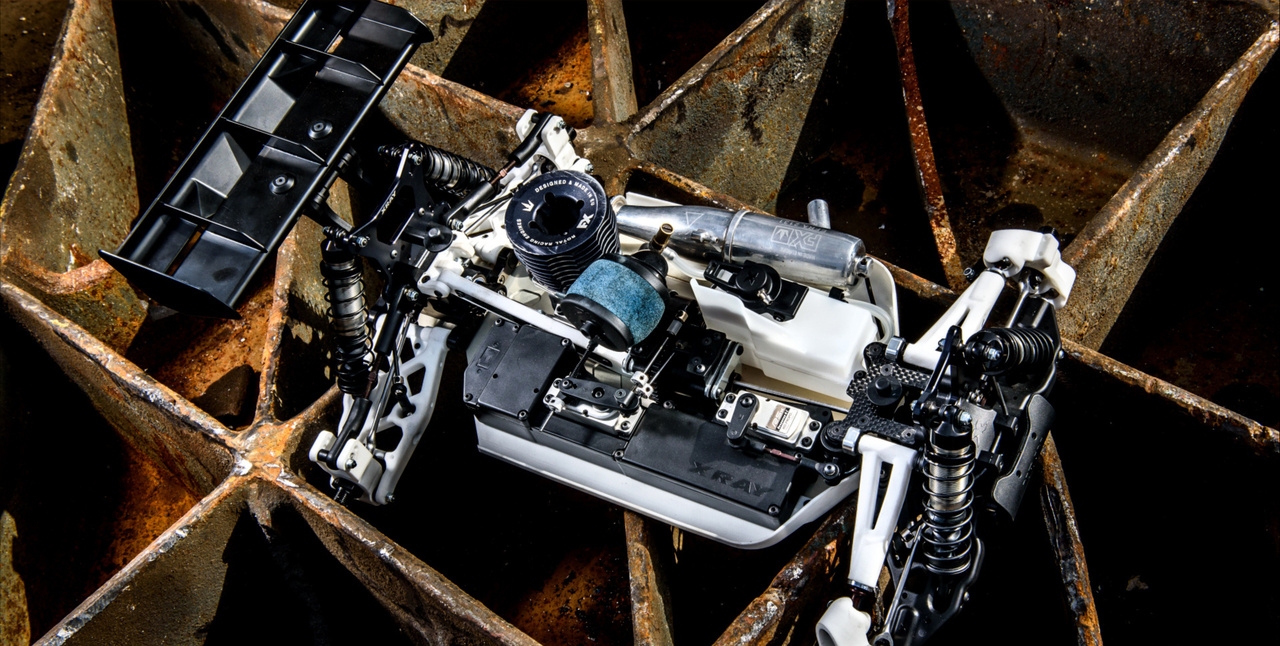
The prototype with the conventional pivot ball suspension made the car a little bit more stable but still very reactive which I really liked but Juraj did not feel any difference which was good because for a normal driver the car will be still easy to the drive but the high competition racing customers will feel the small improvement in stability. What was most important was that with the conventional pivot ball suspension we were able to avoid suspension binding in dusty conditions; this was the main reason we wanted to test & compare this suspension style… to confirm or refuse our theories.


In changing from our unique pivot ball to the conventional pivot ball suspension, I was really concerned that we would come under fire from the public with the usual jokes & comments about copies. I tried to chat with Juraj about other possible solutions, but any time I came up with different concerns Juraj settled me down and reminding me that no matter how hard we try we will not reinvent the wheel, and everyone will always build something based on some other previous designs.
So I simply had to learn to live with the fact that no matter what we will do, there will always be some haters and I need to focus on the positive side which is the improvements we will bring to customers. In the end it is the customer that is the most important judge of our work, so despite the concerns I kept a positive mindset that we would cure the binding issue in the dusty conditions, and make customers happy. Also, I knew of another upcoming project where we will be able to use our unique pivot ball, so it will not be lost & forgotten.


After this most important & fundamental decision, I could start working on the rest of the car. The front suspension was settled and I could work on all details around it. The next step in testing – and also the most time consuming – was the changes to weight balance & flex. I spent a few days brainstorming with Juraj and R&D on the various designs of the chassis I wanted to try.
We put into production various prototypes of all different lengths, weight balance positions, and widths in front & rear. Some of the chassis that I ordered from Production were almost “blank” so I could use drills, Dremel tools, etc. to adjust & cut the openings to my desire. With this flexibility I did not have to wait for Production and could modify the chassis directly at the track with any ideas I had, but of course with certain limitations of other related parts. But still… this flexibility helped me to move forward very quickly.


Along with the major work of testing different chassis, I have probably spent the most time on testing the radio boxes. I equipped myself with boxes made from various materials… all to test & compare the differences in handling. I hand-modified several different designs with some crazy modifications… just to see what happened. Most of the modifications were tested with different front & rear braces, as these in combination with the radio box had the greatest influence on chassis flex.
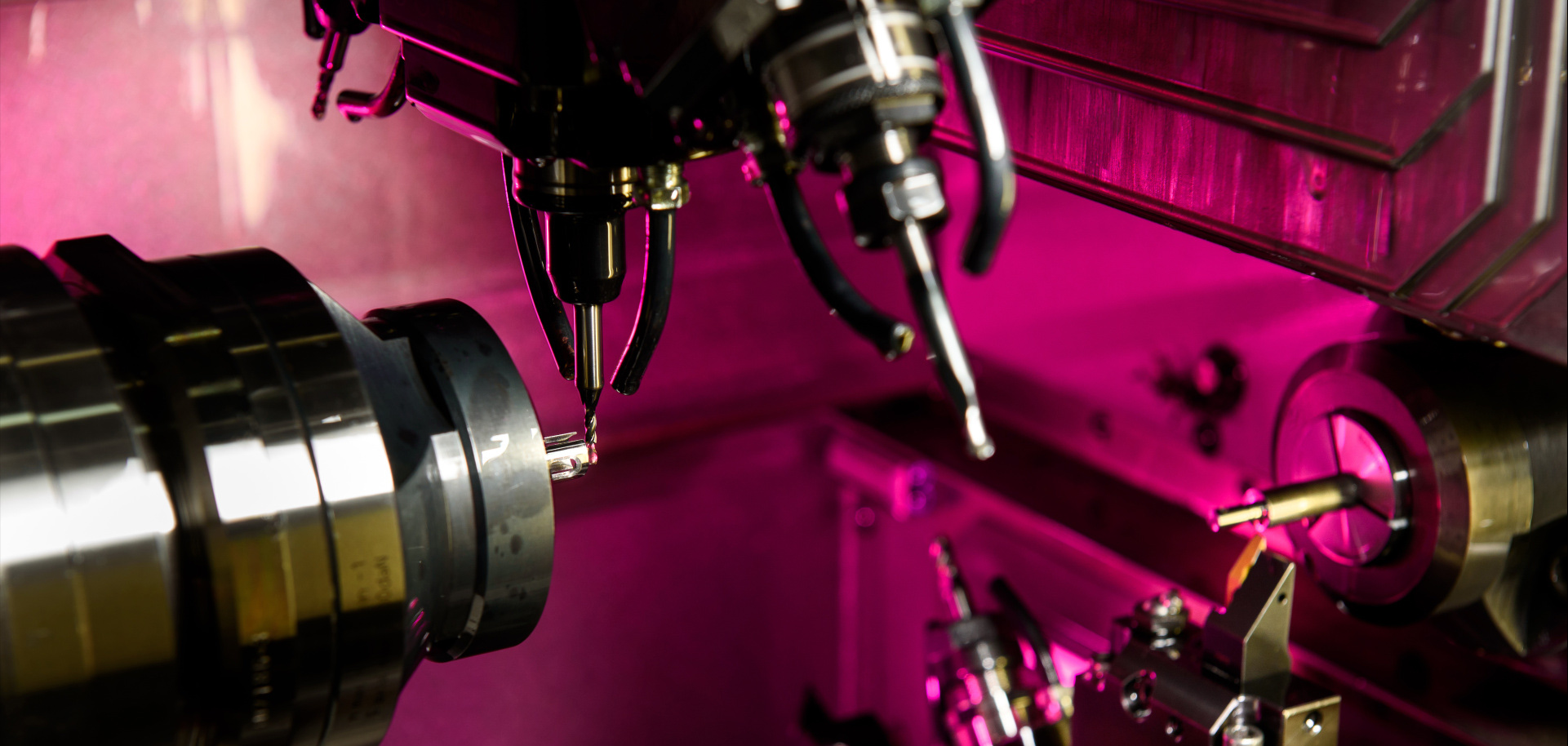

With all the different areas I wanted to test, I had plenty of prototypes available. Sometimes I did a few tests but was not happy. For example, I was not happy with the flex of the new rear brace, so I had to go back to Production to modify the other remaining prototypes. The next time I had the feeling that despite making huge progress with the stability of the car in rough tracks, I still wanted to test different shock combinations so I ordered various shock body lengths and different shock body parts to test.
“Extensive” is the word I would use to best describe the teamwork between R&D, Production, and myself to move quickly forward with development. I cannot imagine how much longer this type of flexible development would take if we outsourced anything for production or made it somewhere in Asia like others, but for sure it would take several times longer.


I was satisfied with the progress, and finally I had a good, balanced car on my hands. Now was the time when we could approve the production of the prototypes for the team, and to arrange the cars to be run in different track conditions. No matter how satisfied I was with the car, the feedback from the team would be crucial. Unfortunately at that time, Production was completely busy with XB2 & XB4 production, so we simply had to wait for a free spot in their schedule.
Meanwhile I started to test the car at races, traveled to some national rounds, and attended some international races. The more track time I had with the car, the more I was convinced that we had made real progress. While I still felt some small improvements could be made, I decided to wait to hear back from the team.


As the production capacity again opened up, we could produce the prototypes for the team. There was a race on schedule at Padova track in Italy, so I hurried up Martin Wollanka to come with me to the race for some more side-by-side testing. For Martin W, this was first time he hit the track with a complete prototype instead of just some individual parts I provided him to test already before.
I was anxious to hear his feedback, and luckily after a few runs Martin was very satisfied with the handling and also was running faster. A small bit of tension was relieved. After I returned home from Italy, I got in contact with Yannick Aigoin to arrange a test session in France. Unfortunately, the weather went from bad to worse every day, so I had to postpone testing with Yannick. We had a limited number of prototype cars to send out to drivers (then collect them back afterward) depending on the race schedule on different weekends; this was a bit of a complication, but nothing serious.


I continued to perform more testing on my own as well as collect feedback, and from that we worked on further small improvements. This time I focused on the shocks & springs. With the various lengths of shock bodies available, I have selected some favorites and convinced Juraj to design & test all-new spring designs which would have a mix of both linear & progressive characteristics. I wanted to have progressive springs at the beginning of compression so the car does not seat immediately in a corner, but then wanted a more linear rate as the spring is compressed more so in fast corners the car holds its line better. I knew this was only an idea that nobody had done before, so I have expected some complications.
Luckily and to my surprise it went quite well! I have received a few different spring designs and different lengths to test, so again I had plenty of testing ahead of me. I was surprised right away with the significant difference in handling: the car rolled better through the rough parts of the track but also got quicker in fast corners as expected. I continued to test the new springs and was really quite satisfied with them at all the different tracks. From all the different designs I selected 2 designs which worked in nearly all track conditions, so there will not be a huge range of different springs available as option.


Time flies so fast that I did not realize it was already the beginning of 2016, and the new season was just about to start. I was under time pressure as Juraj was pushing me to hand everything to Production, but I was still uncertain about some areas.
I had to keep in mind that Production also runs other XRAY projects, and mould changes in particular take up the most of time. I really hate those moments when you need to make The Decision, but you know that something should be still tested or something could still be improved… but you are running out of time and must quickly decide what to do. After extensive discussions with Juraj, we decided to at least start production of all confirmed parts, and we also decided that we would do some final tests during our annual USA trip.


I wanted to spend as much time as possible at various US tracks, but Juraj did not have so much time, so we decided that I would fly in earlier. At the beginning of February I was back in the USA to test at local tracks, followed by the Sin City race in Las Vegas, and then the Dirt Race. At the Sin City race, track conditions again get different from all the practice conditions and I have found some areas which could be still improved.
I called Juraj at home and explained to him all the modifications I wanted to make to the chassis and the side guards. I understood that Juraj was leaving to join me in only a few days, so I did not expect anything other than to simply report my findings to him. But once again Juraj proved he is the master of complete determination for the “no compromise” attitude. I do not know how Production did it, but for sure they broke another world record.
Within a few days, Juraj landed at the Las Vegas airport with a bag loaded with new parts (just like Santa Claus). He had not only aluminum parts, but also composite side guards which Production had to modify & build the mould and inject. It is times like those that make you feel like nothing is impossible, but then I get back to reality in realizing that several machines had to stop in the middle of a production run, staff had to temporary stop their standard work, the CAD engineers had to stop their work, and the production manager had to put 100% of the time & effort to produce parts quickly. In the end, prototypes like these are worth their weight in gold.


I wanted to spend as much time as possible at various US tracks, but Juraj did not have so much time, so we decided that I would fly in earlier. At the beginning of February I was back in the USA to test at local tracks, followed by the Sin City race in Las Vegas, and then the Dirt Race. At the Sin City race, track conditions again get different from all the practice conditions and I have found some areas which could be still improved.
I called Juraj at home and explained to him all the modifications I wanted to make to the chassis and the side guards. I understood that Juraj was leaving to join me in only a few days, so I did not expect anything other than to simply report my findings to him. But once again Juraj proved he is the master of complete determination for the “no compromise” attitude. I do not know how Production did it, but for sure they broke another world record.
Within a few days, Juraj landed at the Las Vegas airport with a bag loaded with new parts (just like Santa Claus). He had not only aluminum parts, but also composite side guards which Production had to modify & build the mould and inject. It is times like those that make you feel like nothing is impossible, but then I get back to reality in realizing that several machines had to stop in the middle of a production run, staff had to temporary stop their standard work, the CAD engineers had to stop their work, and the production manager had to put 100% of the time & effort to produce parts quickly. In the end, prototypes like these are worth their weight in gold.


If you think that you can take a rest at XRAY when you finish a project… well… you would be wrong. Already I am hard at work with the all-new XT2 – the new 1/10 stadium truck. Follow us on our social media accounts for all the latest news and exclusive information; I will bring some more insight into this all-new platform very soon. I will be travelling to all major races in the coming summer season, so do not hesitate to come to see me.
Meanwhile enjoy the new XB8 and have fun!

